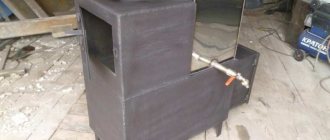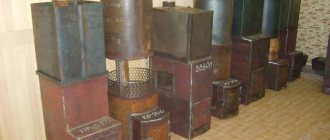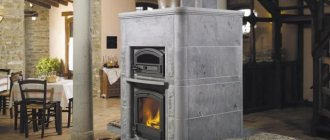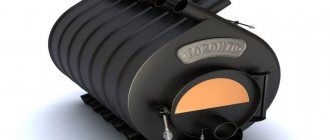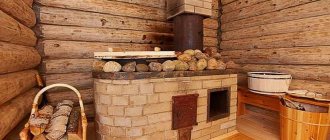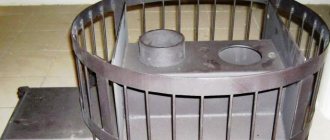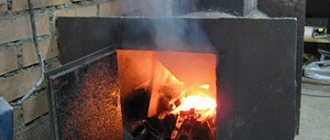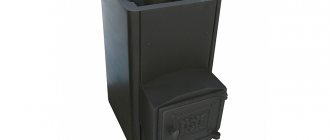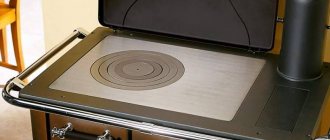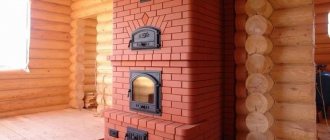In a classic Russian bath, the main source of heating was a wood stove. The heater was made of refractory bricks and clay and served for many years. In modern baths, a metal stove has become an alternative to a brick stove.
In both design options, brick lining is popular. If for a traditional heater this is done more for the purpose of decoration, then for metal ones it is about longer heat retention, fire safety and only then decoration.
Users also search for:
- Heat-resistant plaster for stoves
- What stones are suitable for a bath
Advantages and disadvantages of a sauna stove
Sauna stoves are varied. They are made independently or purchased ready-made models in stores. Brick is used as the main material for the construction. This decision is due to a number of advantages.
The advantages of brick kilns include:
- Long-term heat retention;
- High quality steam;
- Great power;
- Fire safety;
- Creating a pleasant microclimate;
- Environmentally friendly.
The peculiarities of the material and original appearance allow you to create a pleasant antique atmosphere in the bathhouse.
Despite their advantages, brick stoves have a number of disadvantages:
- Heavy weight;
- Foundation requirement;
- High manufacturing cost;
- Demanding qualifications of specialists;
- Long fire.
To make a high-quality stove, you must have experience in laying bricks. If the masonry turns out to be uneven, the quality of the room’s heating decreases.
A few final words
The labor costs and money spent on lining a sauna stove are more than justified.
A brick casing increases the operational safety of a metal stove; heat is distributed evenly, since the artificial stone first accumulates heat and then releases it. And the heat is retained much longer; you can steam in the sauna comfortably for several hours in a row. The benefits are obvious.
- Date: 01/18/2015 Comments: Rating: 45
It is known that the result of a trip to the bathhouse depends directly on the quality of the installed stove. Most owners prefer to use this attribute in a metal version.
Of course, stoves of this type can be installed in a short time, heat up quickly, have attractive appearance and are notable for their low price. However, they do not retain the heat of the base for long and cool down in a short time. Therefore, there is a need to periodically add firewood.
If you have a metal stove in your bathhouse, then to improve the distribution of heat throughout the steam room and increase safety, it is better to line it with bricks.
To heat the entire room, you need to spend a sufficient amount of time. The walls of the stove become very hot, as a result of which they quickly wear out. To increase the time of using this attribute and create conditions for more productive distribution of heat throughout the steam room, experienced craftsmen often resort to covering its base with a certain material. Let's consider what kind of brick to line a sauna stove and what material will give the best performance.
Features of modern sauna stoves
When creating a furnace, you must carefully consider the choice of design and development of drawings. The design features of the product will directly depend on the heating option.
The main options are:
- In black - with no chimney;
- In gray - with a chimney, but there is a need to wait for the wood to burn out;
- On white - there are no signs of soot in the room, the stove has a chimney;
- With a stove is the most successful option; it is based on a tank, a stove and sauna stones.
When building a modern stove, special attention should be paid to the choice of a water tank, firebox stones and additional elements. Brick, as the main building material, allows you to retain heat for a long time and maintain the desired temperature in the steam room.
Tank selection
The water tank is selected before construction work begins. Its volume directly depends on the number of people simultaneously in the steam room. The more traffic the room has, the larger the tank should be. In the classic calculation, 1 liter per person is taken.
Experts recommend giving preference to open tanks. Such containers are easier to maintain and fill with water. During periods of prolonged inactivity, it is recommended to empty the water from the tank.
Firebox stones
Stones play an important role in the steam room. Their choice should be approached carefully. Ordinary cobblestones are not suitable for a bathhouse. They have microcracks and additional inclusions, which have a negative effect on the material during sudden temperature changes and can explode.
Stove makers recommend using jadeite, soapstone, or river tracing paper as stones. In case of financial difficulties, the use of basalt or vulcanite is allowed.
Brick selection
For masonry, most builders use ordinary solid red brick.
- It is distinguished by good behavior under temperature changes and a long service life.
- Red brick performed best in the construction of the main structure.
- However, in the firebox, under the influence of temperature and moisture, it quickly collapses.
Fireclay material is used to lay the firebox.
Additional items
Additional elements in the design of a sauna stove are metal inserts: doors, grates, grates and other systems. They are purchased ready-made; it is recommended to buy a full set. It contains everything necessary for the construction of the structure.
- When purchasing metal products, take into account the dimensions.
- It is important that they comply with the parameters specified in the bathhouse design.
- If there are no such items on sale, then they buy those that are as close in value as possible. Dimensions are adjusted using bricks.
Subtleties of lining a stove with bricks depending on the room
The stove is installed directly in the steam room or the firebox is placed in the dressing room. Let's look at the nuances of each option.
In the dressing room
The advantage of a stove with a remote firebox is that it heats two rooms at once: a steam room and a dressing room. Great for small baths. It differs from conventional metal units by the presence of a fuel channel.
When installing, it is important to remember fire safety rules. The minimum distance from the wall is 0.5 m. Sections of the walls near the stove must be sheathed with thermal insulation; a protective fireproof screen can be installed.
The distance from the firebox door to the wall or door is at least 1.25 cm. It should be located towards the door to the steam room.
For a unit with an external firebox, the installation of the partition is carried out in stages as follows:
- A place for the oven is selected. The foundation is poured (detailed instructions are given in the section below).
- After the foundation has completely hardened, the structure is placed on it. An opening for the firebox is marked on the wall. It should be larger than the camera itself, 25 cm on each side. The exact choice of opening dimensions for a specific stove model is indicated in the product data sheet.
- A hole is cut with a grinder. Pieces of excess material and debris are removed.
- It is recommended to place the stove on the foundation again to check the correctness of the hole made and the evenness of the base.
- The oven is being cleaned. Thermal insulation material is being prepared.
- Basalt cardboard is taken and cut into strips. Attached to the walls of the hole with a stapler. Then the ceramic fabric is fixed in the same way.
- Aluminum foil is attached to the stapler.
- Take two sheets of mineralite. Carefully cut out a hole for the firebox.
- The blanks are placed on the side of the steam room. Mounted to wooden walls using self-tapping screws.
- The brick for facing is soaked in water. The mixture is being prepared for ordering.
- The masonry work begins in the dressing room. The first row needs to be laid in half a brick. The last elements of the row are placed across, so you get beautiful protrusions.
- In the second row there is space left for an ash pan. Air circulation will occur through it.
- The minimum distance from the stove body to the partition is 3 cm.
- When the height of the masonry is reached above the firebox, two steel corners are placed in the brick row. This will prevent contact with metal.
- Now the foil and the remaining cardboard are carefully trimmed. When a gap is formed, it is filled with mineral wool. They compact well.
- At this stage, laying in the steam room begins. The stove is placed on the foundation.
- The chimney pipe is connected.
- Marking is being carried out. A partition is created in the same sequence.
Another advantage of this design is that it reduces the risk of carbon monoxide entering the respiratory tract. Oxygen remains in the steam room, since fuel combustion occurs in another room.
In the steam room
This arrangement is less expensive in terms of materials, but requires increased attention and compliance with fire safety rules. There are open-type designs where stones are laid on top of the stove. By pouring water on them, you can regulate the amount of steam in the room.
A step-by-step guide to installing the unit in a steam room is described in the section below.
Recommended reading:
- How to clean a chimney
- Installing a stove in a bathhouse
Construction technology
Construction of a furnace is not a quick process. The work takes on average at least 1 month. The period directly depends on the qualifications of the specialist and the speed of installation. Most of the time is spent preparing the foundation and hardening it.
The main stages of work are:
- Preparation and pouring of the foundation;
- Preparation of tools and solution;
- Construction of the masonry of the main part of the furnace;
- Construction of a chimney;
- Finishing work.
All stages are carried out sequentially, observing the time limits for hardening of the solution.
Pouring the foundation
The foundation is the basis of the entire building. There are increased demands placed on him. The foundation must be strong and reliable, capable of supporting the heavy weight of the building.
The construction of the foundation is carried out according to the scheme.
- Dimensions are applied to the base. Pegs are driven into the corners, and a thread is pulled over the stakes for ease of orientation. The size of the markings corresponds to the dimensions of the oven.
- Prepare the pit. Depth – 60-70 centimeters, the lower part is additionally expanded by 10 centimeters to the sides. The shape of the pit should be trapezoidal.
- A layer of sand 5-10 centimeters thick is poured onto the bottom. Broken brick or crushed stone is poured on top. Sand is also sprinkled on top. The thickness of the puff pastry is approximately 25-30 centimeters.
- Waterproofing is laid on top of the compacted brick with sand. Traditionally, roofing felt is used.
- Formwork is installed around the perimeter of the pit. A reinforcing mesh is installed in the pit itself.
- The formwork is poured with concrete. In this case, 10-15 centimeters are left to the top. They are necessary for leveling the surface and laying the base layer of bricks.
The foundation is allowed to settle and set. This period takes from 5 to 7 days, after which the formwork is removed. The voids are filled with gravel. Roofing felt is laid on top of the foundation. It is recommended to do waterproofing in two layers for reliable protection against groundwater leakage.
Preparation of the solution
It is not recommended to use cement mortar for masonry. It is not heat-resistant and does not tolerate temperature changes well. Experts recommend starting a mixture based on clay and sand.
There are no exact proportions for the composition. Focus on consistency.
- Clay is used red or fireclay. No large inclusions.
- The material is filled with water and left for 24 hours. After this, knead until soft. The clay should stick slightly to your hands.
- After this, sand is introduced, previously sifted through a sieve.
- The composition is mixed until homogeneous.
The readiness of the solution is determined by dipping a stick into it and shaking it. If the remaining layer exceeds 3 millimeters, then sand is introduced. If less than 2 – clay. The optimal layer is 2 millimeters.
Sheathing stages
Before you line an iron stove with bricks in a bathhouse, you need to prepare. To carry out the work, the master will need M150 solid brick, clay, sand, concrete, crushed stone. To create the formwork you will need boards, waterproofing and rods for reinforcement. The tools you need to prepare are a level, a shovel, a tape measure, a pencil, a trowel, and a plumb line.
Attention! If the stove came complete with a convection casing, it must be removed, since its role is now played by the lining.
Today there are many types of iron stoves, the lining of each of them has certain nuances Source wp.com
Foundation construction
The strength of the stove structure and how long it will last will depend on the foundation, therefore, it is better to choose which stove in the bathhouse at the design stage. If the total weight of the stove with laid masonry is no more than 750 kg, a separate foundation will not be required for it. Otherwise, you will need to carry out a number of works to arrange a reliable foundation. In general, they do not differ from the work on arranging any other foundation:
- If the foundation is strip, then a pit is dug for it, in which the formwork is installed and waterproofed.
Heavy metal stoves will require a reinforced foundation Source banya-expert.com
- When the formwork is ready, a 20 cm layer of crushed stone and sand is poured over it, then it is watered and compacted.
- Reinforcement is laid and a mixture of concrete, sand and crushed stone is poured (in a ratio of 1: 4: 3). Everything is leveled up; if necessary, flaws are corrected.
- After the poured foundation is left to harden for approximately 14-20 days.
When the concrete has completely dried, the base is laid: waterproofing is made from roofing felt, and metal sheets 1-2 mm thick are laid on top of it, on which there will be an iron stove.
Brickwork
Brick laying is carried out according to a pre-developed plan. During work, it is important to maintain the sequence of rows and the evenness of their construction. The first row should be perfect.
The general scheme for discharging a brick sauna stove with your own hands consists of a number of steps.
- The first row sets the general direction of the walls. Must be perfectly smooth. A plumb line is made from it to check the vertical.
- The next step is to make the ash pan. Its tasks include collecting waste generated during the combustion process.
- The third and fourth rows are responsible for attaching the blower. A metal strip is used to secure it. The blower is responsible for regulating the combustion process. Open position – intense flame, closed – small flame.
- After the fifth row, steel corners for the grate are laid.
- Starting from the 6th row, a firebox is installed. Fireclay bricks are used for it. The height of the firebox is 25 centimeters, the width is just over 30. A grate is placed on top of the firebox.
- In the last rows, the firebox area expands. Refractory bricks are used for external masonry. Openings are created for secondary air supply. They are made of bricks cut with teeth.
- The laying continues with the outer brick. Doors for the firebox and a partition for the chimney are installed.
- A water tank is installed.
- At the height of the 15th row, the firebox is covered with a slab of refractory material, and stones are laid on it.
- The laying of the compartment under the stones begins. Its size depends on the number and size of stones.
- The chimney is laid out last. Fireclay bricks are used for it. The chimney gradually narrows upward. Exited through a wall or roof. The passage points through the bathhouse partitions are lined with thermal insulation. The last to be installed is a chimney protected from rain and dirt.
During operation, the solution is applied to the previous row. The brick is laid with the smooth side facing the chimney. The vertical and horizontal lines are checked after each row. The remaining solution from the side surface is cleaned every 3-4 rows. After laying out, the oven is left to dry.
Finishing
Finishing for brick stoves is not mandatory. Finishing allows you to hide minor imperfections in the masonry and give the stove a complete, stylish look. The most common design option is tile.
There are 3 types of ceramic tiles for finishing the stove in the bathhouse.
- Terracotta. High strength tiles with a porous base. Has excellent adhesion to the surface.
- Majolica. It is distinguished by the presence of a top layer of glaze. It has excellent performance characteristics and an attractive appearance.
- Clinker room. It is made from a mixture of clays with the addition of fireclay powder and pigments. The material is fireproof. Has high strength. It is most suitable for ovens.
You can line the stove in the bathhouse with brick or decorative stone. The design made of porcelain stoneware, marble, granite, and coils looks good.
A brick sauna stove is not only functional, but also a beautiful structure that can create the amazing atmosphere of an old bathhouse. Compliance with installation technology and proper selection of equipment will allow you to create a reliable and functional product that will last a long time.
Stove cladding options in photographs
Below are ready-made options for cladding stoves that will fit perfectly into the interior of frame baths, as well as baths made of logs and blocks. The furnace firebox is located both in the steam room and in the dressing room.
